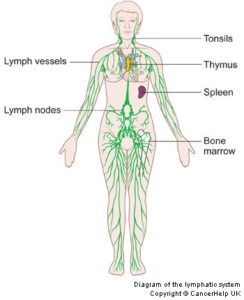The lymphatic system is often associated with cancer treatment and recovery. This system is responsible for collecting the fluid and proteins that build up in the body tissues. It then transports them back into the blood. It also has important roles in immune function and fighting infection. A series of very fine lymph collectors start from just under the skin and carry the fluid through larger and deeper vessels. There is no pump for the lymphatic system, so fluid moves mainly due to pressure changes and muscle activity.
Damage to the lymphatic system due to cancer treatments is the most common cause of lymphoedema, called secondary lymphoedema. However, some people are born with an inadequate lymphatic system. This is called primary lymphoedema and is much less common.
Lymphoedema following Cancer Surgery
Secondary lymphoedema after cancer surgery often affects one limb, ie. the arm on the side of the breast removed. More commonly lymphoedema develops after removing large amounts of lymph nodes, but can occur after removing very few. Removing lymph nodes on both sides can cause swelling on both sides of the body. Early symptoms can include a feeling of heaviness in the limb and mild swelling that resolves at night. However, this will often progress into a more pronounced swelling. If left untreated the swelling can increase and thicken (fibrose) and impact quality of life. After progression to the permanent swelling stage, swelling is not curable. However, therapy can minimise it’s effects and progression.
How to treat Lymphoedema:
- Manual Lymphatic drainage (Lymphatic massage)
- Bandaging
- Wearing a garment
- Exercise
- Looking after your skin
At Central Lakes Physio we can provide lymphoedema therapy, Vicky has been trained using the Vodder technique through Klose training and is also a Pinc and Steel Cancer Rehabilitation provider.
